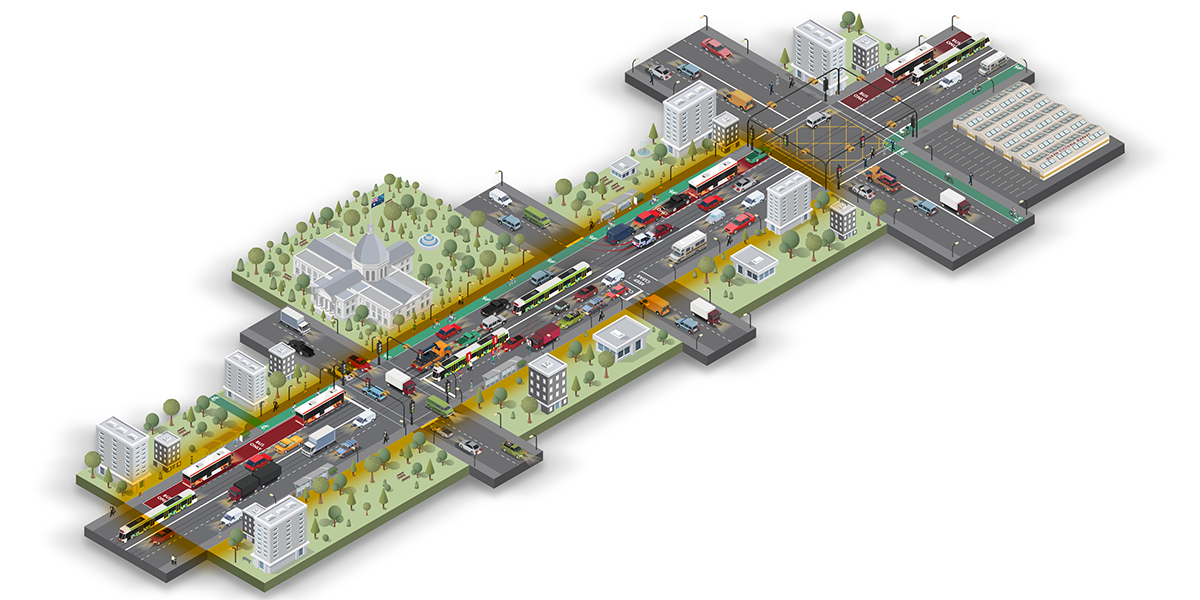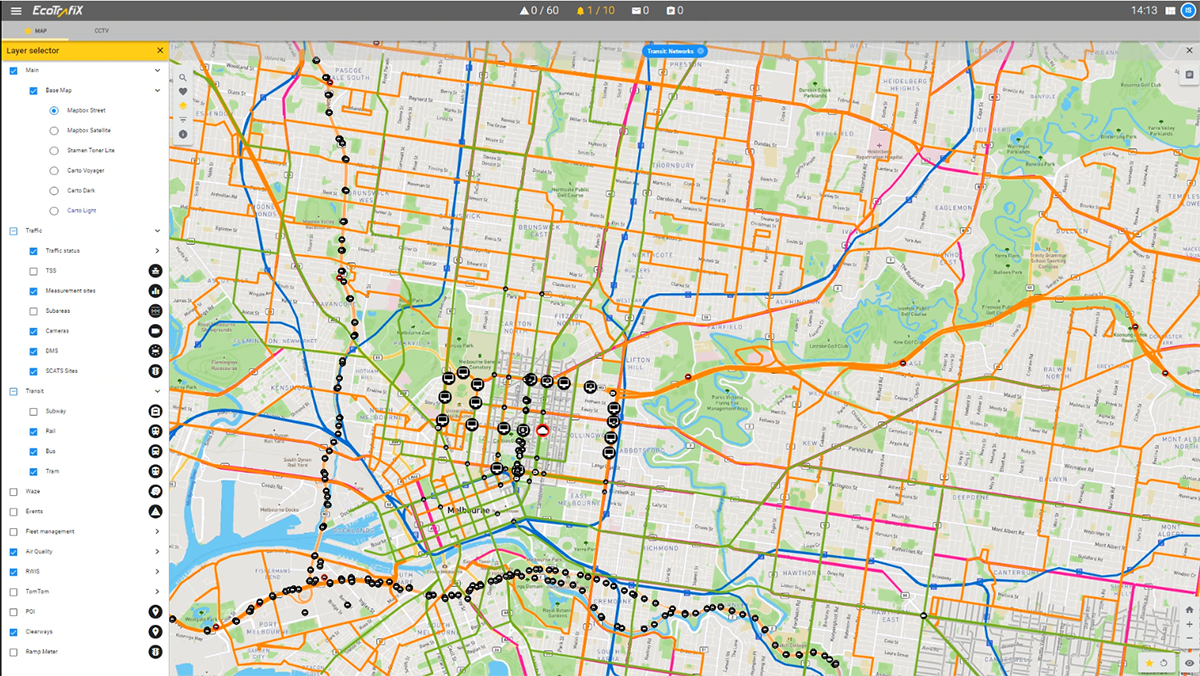6 Minute read
Austrian tech firm Kapsch TrafficCom and the University of Melbourne have partnered to optimise a busy stretch of inner-city Melbourne road. The project pairs traffic sensors with advanced AI technology to improve the safety and flow of people – not cars – through the corridor.
Key points
- Although personal cars are the least sustainable mode of transport, Melbourne’s intersections currently prioritise their throughput
- A 2.5 km test corridor along Nicholson Street in inner-city Melbourne pairs traffic sensors with advanced AI technology to improve the flow of traffic and safety for all modes of transport, including pedestrians, bicyclists and public transport, creating a true multimodal ecosystem
- This project also investigates if new load-balancing technologies within integrated corridor management can be used in a dense urban area across a multimodal environment, rather than the traditional setting of major roads and freeways
- The test corridor is part of the Australian Integrated Multimodal EcoSystem (AIMES), a world-first living laboratory that tests highly integrated transport technology in Melbourne
- The Intelligent Corridor is a project conducted in partnership between the University of Melbourne, industry partners Kapsch TrafficCom and the Advanced Mobility Analytics Group, and the Victorian Government Department of Transport and Planning.
The outcome
Located on Nicholson Street in Carlton, the Intelligent Corridor is supported by a total $2 million Australian Research Council Linkage grant, with contributions from the University of Melbourne, Kapsch TrafficCom and the Advanced Mobility Analytics Group.
“We’re taking a holistic demand management approach for how to optimise that corridor to move people – not vehicles – as effectively as possible,” says Kapsch TrafficCom’s David Bolt.
Launched in 2022, the project proceeds in three phases:
- Data infrastructure building by integrating existing and new sensors in AIMES
- Platform core deployment, and simulating the effects of potential changes to the corridor
- Measuring the benefits of the technology by implementing the best strategies to optimise traffic flow and a dashboard to show improvements.
“We have a large team of researchers that work with industry-defined research questions and products that are immediately going to be used by industry,” says Dr Neema Nassir, Senior Lecturer in Transport Engineering.

Deployment of the simulated solutions is expected to begin in 2024.
For example, shifting just 4 per cent of traffic volume away from the corridor could improve the throughput of people by 12 per cent, according to preliminary results from simulations run by the University of Melbourne. ‘Load shifting’ like this can spread peak traffic along the network to decrease the overall peak traffic volume in one single arterial road, like Nicholson Street.
“For every 1 per cent you move, you get a 3 per cent gain,” says Bolt.
The need
Melbourne’s intersections currently prioritise cars. Traffic lights aim to minimise delays and maximise the throughput of vehicles.
“Cars, especially if they are single occupancy, are the least efficient mode of transport from the system performance perspective, and are the least sustainable in general,” says Dr Nassir.
Cars account for 10 per cent of Australia’s greenhouse gas emissions. Multimodal use of road space – for example by bicycles, pedestrians and public transport – can reduce fossil fuel emissions. Switching driving for walking or cycling can also improve individuals’ health and wellbeing.
We need traffic systems that can detect and equitably allocate time to all modes – and ensure the safety of all road users.
492 people died in crashes in Melbourne intersections between 2006 and 2019. Pedestrians, bicyclists and motorcyclists are overrepresented in fatal crashes.
“If you keep many pedestrians who want to cross the street waiting at a red light for a long time, the number of jaywalkers may go up significantly, especially if there's a tram that is departing from the other side of the street,” says Dr Nassir.

Like most older cities around the world, the Intelligent Transport Systems (ITS) infrastructure in Melbourne is dated. Complete situational awareness of the network is only achieved by dealing with multiple systems and platforms. Modernising the infrastructure requires innovative methods for critical control system integration that can make best use of existing infrastructure where possible.
A system that can account for all road users could reduce the number of fatal accidents, improve the sustainability of our transport systems and ensure fair roads for all.
The research
To detect people, the Intelligent Corridor integrates data from a variety of sources:
- CCTV footage
- Bluetooth signals from personal devices
- Sydney Coordinated Adaptive Traffic System (SCATS) data provided by the Victorian Government Department of Transport and Planning
- General Transit Feed Specification (GTFS) data on public transport, also provided by the Victorian Government
- Sensors installed by the Australian Integrated Multimodal EcoSystem (AIMES), including air quality sensors.
SCATS was developed in Australia in the 1970s as a smarter way to manage intersections. Using inductive loops embedded into the road, the system measures gaps between vehicles. If the gap is low, the system determines that the traffic must be heavy and works to extend the green traffic light time for that direction.
“It’s a simple logic, but it’s proven to be very effective in responding to the volumes that compete for right of way at intersections,” says Dr Nassir.

Machine learning-based image processing of CCTV footage helps the team identify the types of vehicles, but also pedestrians and bicyclists. The image processing system also identifies ‘near misses’, evaluating safety risks and conflicts between modes of transport.
Kapsch’s innovative and globally proven corridor management platform ‘EcoTrafiX’ allows the research team to visualise the rich data sources.
University of Melbourne researchers contribute independent data analysis and simulate changes to the corridor.
“We develop machine learning models that can optimise – through millions of simulation executions – the best right-of-way allocation, or the best green traffic light time allocation for competing modes and competing volumes,” says Dr Nassir.
“Having a software platform to integrate all these sources of data is what the University of Melbourne team has needed before. And that's where we've come in,” says Bolt.
“What we've needed are the data and the simulations. That's where the university sits. It is such a great partnership leveraging both strengths.”
Developing the solution
AIMES was established in 2016 to deliver safer, cleaner and more sustainable urban transport outcomes. It is led by the University of Melbourne and has more than 50 partners in government, transport and technology.
AIMES is a living laboratory, with smart sensors and systems installed across 100 km of Melbourne’s inner north. The ecosystem enables projects like the Intelligent Corridor that are exploring better transport outcomes in a dynamic real-world environment.
Partners
- Kapsch TrafficCom
- Advanced Mobility Analytics Group
- Victorian Government Department of Transport and Planning
- University of Sydney
- EPFL
Funding support
$746,657 ARC Linkage grant (LP200301389), with in-kind contributions amounting to $2 million in total funding
People
- Professor Majid Sarvi
- Dr Neema Nassir
- David Bolt
- Professor Egemen Tanin
First published on 25 August 2023.
Share this article
TechnologyInfrastructureClimate changeFaculty of Engineering and Information Technology
Keep reading
-
Explore more Transport research
Creating sustainable transport systems and more liveable cities. Our research is focused on contemporary topics in transportation engineering, including automated vehicles, public transport and multimodal mobility-as-a-service systems.
-
Why partner with us
Partner with the University of Melbourne. Join a community where the world’s best minds help solve the biggest global challenges of our time.
-
Collaborate with us
Explore some of the many ways you can partner with us to help your organisation excel.
-
Connected transport systems that work for more than just cars
Dr Neema Nassir leads research projects in collaboration with governments in Australia in public transport, shared mobility and automated transport.